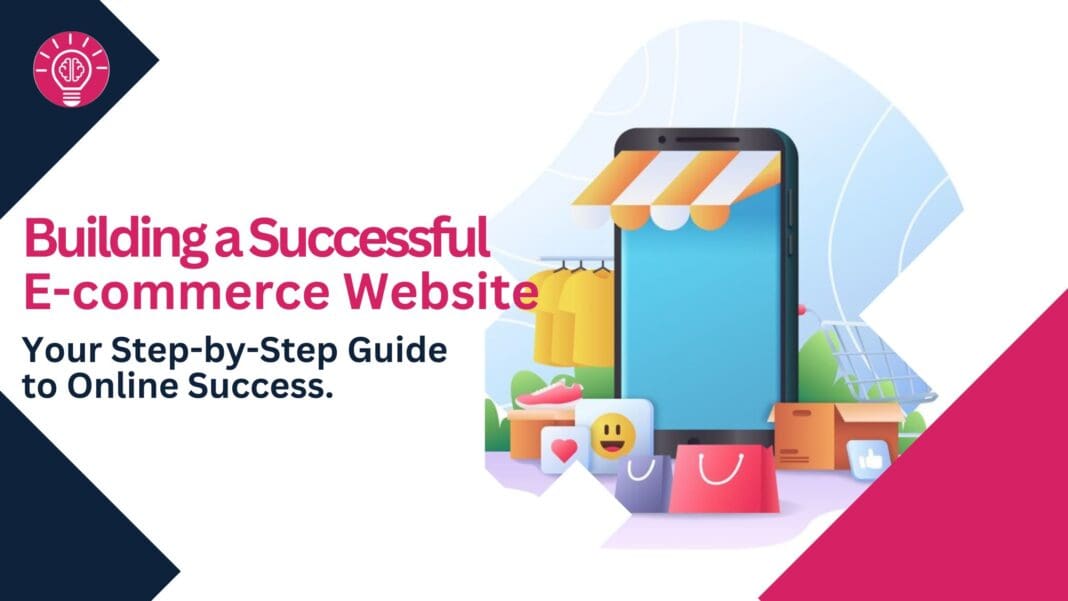Building an eCommerce website is more than just setting up a platform to process transactions—it’s about creating an immersive shopping experience that encourages customers to return time and time again. In the competitive digital world of today, having a robust, engaging site is crucial for attracting visitors, building credibility, and driving growth. This guide from Detroit Website Design Co will walk you through each step, from planning to launching a user-friendly eCommerce site that stands out in the crowded marketplace.
1. Define Your eCommerce Goals
Before diving into building your website, set clear, measurable goals. Do you want to drive sales, increase brand awareness, or foster customer loyalty? Knowing your objectives will guide your strategy. Consider these common goals:
- Drive Sales: If boosting sales is the priority, focus on a smooth and efficient checkout experience.
- Expand Brand Reach: If increasing visibility is key, design a site that showcases your brand’s story and attracts fresh traffic.
- Build Customer Loyalty: If retaining customers matters most, create a welcoming and easy-to-navigate site that encourages repeat visits.
Clarifying your goals helps you align every design decision with what will benefit your business and customers.
2. Conduct Market Research
Understanding the competitive landscape is critical. Take the time to assess what competitors are doing and identify gaps in their approach. Are there features, designs, or products you can offer to stand out?
- Trends: Stay on top of industry trends to cater to your target audience’s preferences.
- Customer Insights: Understand what attracts customers to successful sites in your market.
- Competitor Analysis: Evaluate the strengths and weaknesses of other businesses to carve out your unique position.
Research provides valuable insights that help you create a site that’s not only competitive but innovative.
3. Identify Your Target Audience
Knowing who your ideal customer is allows you to tailor your site’s design, content, and features to match their needs. Ask yourself:
- Demographics: Consider factors like age, gender, and location to shape design and content.
- Preferences and Behaviors: Do they care about sustainability? Do they prefer fast, mobile-friendly shopping?
- Shopping Habits: Do they prioritize convenience, or are they likely to browse and compare products extensively?
Understanding your audience’s behavior and preferences ensures your site speaks directly to them, fostering a deeper connection.
4. Develop Your Brand Identity
Your website is a reflection of your brand. A consistent and cohesive brand identity builds trust and recognition. To create a strong brand identity, focus on:
- Brand Personality: Is your brand fun, professional, or adventurous? Let this influence your design and tone.
- Visual Elements: Choose colors, fonts, and logos that resonate with your audience and represent your brand’s values.
- Tone of Voice: Keep your tone consistent, whether it’s friendly, formal, or humorous.
A cohesive brand identity gives your website a polished look and makes it memorable to visitors.
5. Choose a Domain Name
Your domain name is your online identity. Make it count by choosing a name that’s easy to spell, memorable, and professional. Keep these tips in mind:
- Short and Simple: A short, easy-to-remember domain name will help customers recall your site.
- Avoid Hyphens and Numbers: These can make your URL harder to remember or type.
- Incorporate Keywords: Adding relevant keywords can improve SEO and make your site more discoverable.
Your domain name is the foundation of your online presence, so pick one that’s both functional and memorable.
6. Select an eCommerce Platform
Choosing the right eCommerce platform is vital for the functionality of your site. Consider the following options:
- Shopify: Ideal for beginners, it offers built-in sales tools and ease of use.
- WooCommerce: Perfect for those who want flexibility and control over customization on WordPress.
- BigCommerce: A good option for larger businesses with a substantial inventory.
Each platform has unique features, so select one that aligns with your business needs and goals.
7. Secure Your Web Hosting
Reliable web hosting is essential for a fast and secure website. Depending on your needs, you might choose from:
- Shared Hosting: A budget-friendly option for smaller businesses with moderate traffic.
- VPS Hosting: Offers more control and performance for businesses on the rise.
- Dedicated Hosting: Best suited for high-traffic sites, though more costly.
The right hosting provider ensures your site is always secure and responsive, even during peak times.
8. Plan Your Product Offerings
Decide which products to offer and how to present them in an attractive and organized way. Consider:
- Product Categories: Group items logically for easy navigation.
- Bundles: Offer discounts on product sets to encourage customers to buy more.
- Featured Products: Highlight popular or seasonal items to draw attention.
Organizing your offerings thoughtfully improves the shopping experience and encourages customers to browse more.
9. Design Your Site Structure
A well-organized site structure is crucial for keeping customers engaged and helping them find what they need quickly. Consider:
- Categories and Subcategories: Break down products into manageable sections for better navigation.
- Simple Menus: Keep navigation clean and easy to follow.
- Filters and Breadcrumbs: Allow customers to easily refine their searches or go back to previous pages.
A logical, user-friendly site structure enhances customer satisfaction and encourages longer visits.
10. Create a Seamless User Experience
A seamless user experience keeps customers on your site longer and increases the chances of a purchase. Focus on:
- Mobile Responsiveness: Ensure your site looks great on all devices.
- Fast Load Times: Slow sites turn customers away, so optimize your images and streamline your code.
- Easy Navigation: Make it simple for customers to find what they’re looking for.
A smooth and intuitive experience is key to keeping customers engaged and converting visits into sales.
11. Set Up Essential eCommerce Features
To make shopping as convenient as possible, set up features such as:
- Shopping Cart: Allow customers to easily add and review products.
- Wishlist: Let customers save items for future purchases.
- Product Filters: Help shoppers narrow down their choices by category, price, or features.
- Customer Accounts: Let users save their information for faster checkout and repeat purchases.
These features make the shopping process easier and encourage repeat visits.
12. Prepare Product Descriptions and Photos
Product images and descriptions are your chance to convince customers to make a purchase. Each product page should include:
- High-Quality Images: Show products from various angles for a complete view.
- Detailed Descriptions: Highlight key features and benefits, and include relevant keywords for SEO.
- SEO Optimization: Use keywords that make your products easier to find.
Well-presented images and informative descriptions build trust and encourage customers to buy.
13. Optimize for Search Engines (SEO)
SEO is crucial for attracting organic traffic to your site. Start with these basics:
- Keyword Research: Find relevant keywords for your products and pages.
- Meta Descriptions: Write compelling and concise descriptions for each page.
- Image Alt Text: Add descriptive alt text to your images for better SEO.
Effective SEO increases visibility and helps potential customers discover your site.
14. Integrate Payment Gateways
Offer customers multiple secure payment options to cater to different preferences. Common choices include:
- Credit/Debit Cards
- PayPal
- Apple Pay and Google Pay
- Buy Now, Pay Later options
Providing diverse payment options builds trust and makes the checkout process convenient for your customers.
15. Implement Shipping and Fulfillment Options
Shipping is a significant part of the online shopping experience. Offer flexible options such as:
- Flat-Rate Shipping: Predictable pricing for all orders.
- Real-Time Shipping Rates: Based on location and package size.
- Free Shipping with Minimum Purchase: Encourage larger orders.
Clear and flexible shipping options increase customer satisfaction and can help boost sales.
16. Ensure Data Security and Compliance
Protecting customer data is crucial for your business’s reputation and legal compliance. Be sure to:
- Enable SSL: Secure customer data with an SSL certificate.
- PCI-Compliant Payment Gateways: Use secure payment methods.
- Follow Data Protection Laws: Be aware of laws like GDPR, especially if you sell internationally.
Prioritize security to protect your customers and your brand.
17. Plan Your Marketing Strategy
A successful eCommerce site needs a strong marketing plan to attract customers. Consider these strategies:
- Email Marketing: Keep customers engaged with promotions and updates.
- Social Media: Showcase products and engage with new audiences on platforms like Instagram.
- Influencer Partnerships: Collaborate with influencers to expand your reach.
Effective marketing drives traffic and helps grow your brand’s visibility.
18. Test for Quality Assurance
Before launching, thoroughly test your site to ensure everything works properly. Focus on:
- Functionality Testing: Make sure all buttons, links, and forms work.
- Mobile Responsiveness: Ensure the site works well on all screen sizes.
- Performance Testing: Verify load times and resolve any issues.
Testing ensures your site functions smoothly and provides a positive customer experience.
19. Launch and Monitor Performance
Once your site is live, monitor its performance by tracking:
- Traffic Sources: Where are visitors coming from?
- Conversion Rate: How many visitors make a purchase?
- Customer Feedback: Gather insights to make improvements.
Regular monitoring helps you refine your site and grow your business.
20. Optimize and Scale for Growth
As your business grows, keep optimizing your site by:
- Expanding Product Lines: Add new products based on customer feedback.
- Improving Customer Service: Offer live chat for better support.
- Targeted Marketing: Use personalized emails and retargeting ads to boost sales.
Continuous optimization ensures your site stays competitive and responsive to your customers’ needs.
Conclusion: Let Detroit Web Design Co help you build a thriving eCommerce Site
Building a successful eCommerce website requires careful planning, design, and ongoing adjustments. By following these 20 steps, you’ll create a site that attracts, engages, and converts customers. At Detroit Website Design Co, we specialize in custom eCommerce solutions that align with your unique business needs. Ready to launch a high-performing site? Contact us today to get started!








